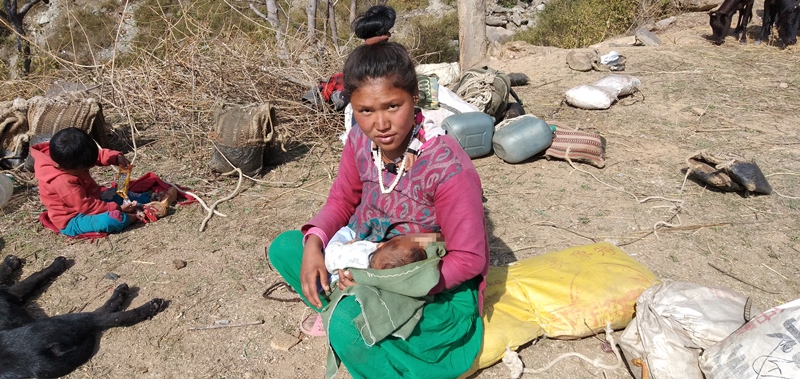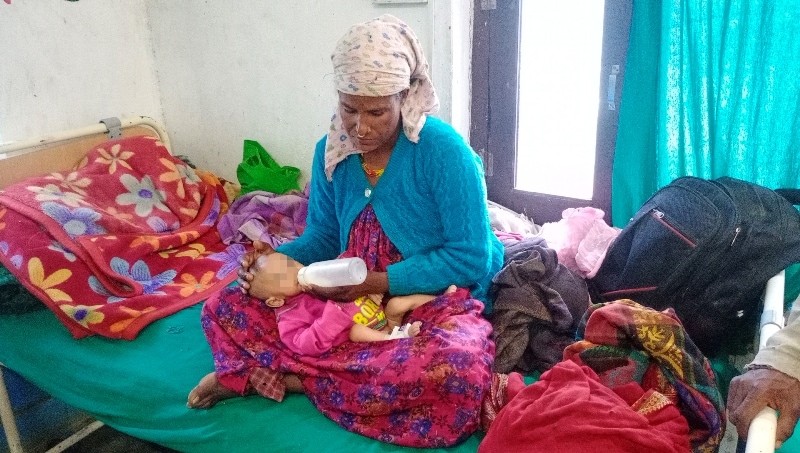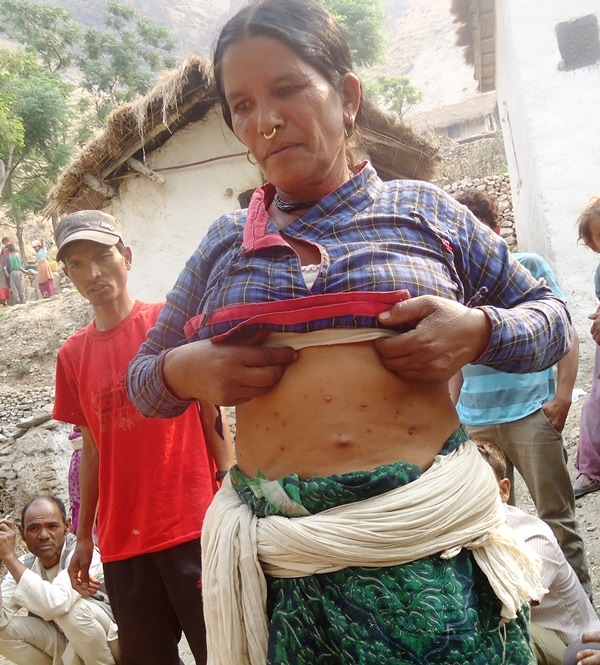Early pregnancy, unsafe delivery, sex-selective abortion and lack of health facilities still pose a great risk to women’s health in Bajura, one of the remotest parts of the often neglected Far-western region.
Nanda Kumari Thapa, Center for Investigative Journalism-Nepal
If one goes by the records of the Bajura District Health, three women had died of birth-related complications in Bajura in the fiscal year 2019-2020. But some numbers seem to be missing there. CIJ’s investigation shows at least five women had died due to birth-related complications in that fiscal year.
Basanti Nepali, a local of Badimalika Municipality-7, was one among five deceased women. She was the first victim of that year. On August 23, 2019, Basanti was admitted at Bajura Hospital after having delivery complications. Doctors later confirmed the baby was dead inside her womb and pulled it out of the birth canal by using a vacuum extractor. An hour later, the mother also breathed her last.

Budinanda Municipality-9, Bajura’s Purna Damai feeding Lactogen to her son, who is malnourished at the district healthcentre in Bajura. Oh Damai’s 13 kids, seven of them are alive today. Photos: Prakash Singh
Twenty days after Basanti’s tragic death another woman, Nirmala Bohara, 35, from Budhinanda-10, Pandusen, also died at the same hospital. Nirmala had given birth to her last baby two years ago. “Her condition was normal when the dead baby was taken out from the womb by using vacuum. But she suddenly died after excessive bleeding,” said Dr Durga Maharjan, who was involved in her delivery process.
This was the second birth-related death in the district.
On November 2, Rejiya Nepali, 37, died at Triveni Municipality-based Chhatara Health Post. Rejiya, a local of Bishal Bazaar, Chhatara, had reached the health office to give birth to her fourth baby. ANM Sumitra Padhya said she felt unconscious six hour after the delivery and breathed her last there.
She was the third woman to die this way.
According to Padhya her condition was normal when she was admitted to the health post. Her relatives had ferried her to hospital around at 11 pm and she had given birth to a baby two minutes after getting admitted. “Her condition was Okay until 4 am. But she suddenly got unconscious after 5 am and died,” Padhya said.
Having no proper care Rejiya’s baby also died in January.
On November 11, Kamala Ukheda of Budhiganga Municipality-7, Jhali, died in Chaukhutte, Achham, while being ferried to Dhangadhi for safe delivery. When Kamala was in labor pain her father-in-law, Umi Ukhada, summoned shaman and spent the entire day believing traditional magic would cure her pain.
When Kamala got unconscious Kamala was taken to Bayalpata Hospital, the nodal hospital, which later referred her to Dhangadhi. “Sadly, she died on the way to Dhangadhi hospital,” said Dipak Shahi, health coordinator of Budhiganga Municipality.
And Pulti Rawal, 35 is the fifth victim. Pulti, a local of Jagannath Rural Municipality-5, had given birth to a baby and was admitted at Gotri Community Health Center on November 25 following excessive bleeding as the placenta got stuck. Rawal’s relatives stated she died on her way to the hospital.
But health officials said they had successfully removed the placenta after she was admitted at the Center. “Bleeding had stopped and she was basking in the sun. But she died suddenly,” said AHW Amar Budha, “Her baby is alive.”
Of the total five deceased four had died at health offices–two at Bajura District Hospital, one at Chhatara Health Post and another one at the Gotri community center–whereas one died on her way to Dhangadhi in hope of finding a better healthcare centre.
Asked whether women are dying at childbirth due to lack of resources as our federal exercises have just begun, Tek Bahadur Khadka, health coordinator at Badimalika, says the number of deaths reflects ‘the level of awareness in Bajura.’
“Very few come for regular checkups. Women are not taken to hospital for delivery service. And there is always a lack of rest and nutritious foods during pregnancy–the critical period for women.”
Patriarchal Mindset
The death of five new mothers has brought the debate of women’s reproductive rights into fore once again. Giving birth to maximum babies is one of the reasons behind the uncontrolled maternity deaths. On an average a woman in Bajura gives birth to five to seven children. Some of them have given birth to up to 12 to 15 babies.
For example, Purba of Budhinanda-1 had given birth to 13 children. Of them, one son and six daughters are alive. “I gave birth to many children hoping to have at least a son. Initially, I breastfed my baby. But I stopped it because the milk dried up.

Manakala Nepali’s family from Amkot, Budimalike Municipality-1. Her 4-year-old daughter is severely malnourished.
Purba said she hasn’t used any contraceptive for birth control so far.
Aawarma Budha, 42, of Swamikartik Rural Municipality, who had married at age of 15 gave birth to her 13th baby last year. Of them, nine babies–seven daughters and two sons, were born alive whereas four babies died while giving birth. Her husband, Payan Budha, said except the last baby, Aawarma had given birth to all babies at home.
Chhamma Luwar, 45, of Jagannath Rural Municipality-4 has just given birth to her 11 children. Of them, seven are now alive. She had married at the age of 11.
“Women have to face abusive words if they are unable to give birth to at least a boy. Many children were born in hope of getting a son,” said Chhama.
The story of Kushukala Sarki, 41, Jagannath Rural Municipality-2 is also not different from other women. Recently, Kushulal had given birth to her twins as her10th children at the age of 41. Her health condition is now very weak.
Dharma Rokaya, a staff nurse working at Bajura Hospital, said women in remote villages of Bajura give birth to at least two to three children even when they are just running in their 20s and continue to give birth till the age of 45 or the time when menopause starts ; although 20 to 35 years is considered to be less risky for pregnancy.
“Many women give birth until they think their life is in risk,” said Rokaya added, “Thus, children can be at greater risk of disability, malnutrition, mental complications. Children’s health always remains in risk whereas the mother may lose her life due to excessive bleeding.”
Women in Bajura feel ignored, humiliated and stressed unless they give birth to a baby boy. Kalpana BK of Badimalika-9 is one victim among many women who have been facing mental torture for their failure to give birth to son. She has already given birth to six daughters and the youngest one is just six-month old. Still, her family is mounting pressure on her to give birth to a son. “My husband has threatened to marry a second wife if I fail to give birth to a son next time. I often want to cry when I recall abusive words of my neighbors.”
Sex-selective Abortion
Many women undergo cycles of selective abortion for son. Laxmi*, a woman of Budhiganga Municipality-10, Sigada, underwent eight cycles of sex-selective abortions. The first and second abortions didn’t affect her health. But she hardly saved her life when she had her third abortion which caused her excessive bleeding. Her family had to take her to India for treatment.
Chandari* of Himali Rural Municipality-6 in Bajura also has a similar story. Chandari was admitted to hospital for critical care after she aborted several times in hope of giving birth to a son.

Manakala Nepali’s family from Amkot, Budimalike Municipality-1. Her 4-year-old daughter is severely malnourished.
Women from hilly villages of Far-western region go to Indian private hospitals to identify sex of their child shortly after getting pregnant and they later abort child in Nepal if a daughter is conceived. Dhauli*, a woman of Badimalka-7 Kordha, identified the sex of her baby in Paliya of India and bought medicine worth Rs 1500 from a Bajura-based medical store to abort fetus.
But medicine couldn’t fully abort and she was suffering from excessive bleeding. Afterward, she was taken to Bajura hospital which later referred Dhauli to Bayalpata Hospital. Doctors save her life but her health is not good. As per Safe Abortion Service Expansion and Work Operation Service Guideline-2066 both the person and organization willing to provide abortion service need to obtain certificate from Department of Health Service and Family Health Division. But unskilled persons have been handling abortion in remote villages of Bajura.
“Although several organizations have been working against discriminations our society hasn’t changed much. That’s why selective abortion is rife—a stark case of gender discrimination, said Rukmani Shah, president of Women’s’ Right Forum, an NGO.
Shah said husbands often marry a second wife, family members expel women and even society humiliates them if a woman fails to give birth to a son. “So, they are forcibly opting sex-selective abortion as we have several cases of discrimination where husband has married a second wife and women are expelled from homes for not giving birth to son.”
Young Mothers
Giving birth on the way is to a healthcare centre is too common in mountainous villages of Far-western region. Rama Gurung, 24, of Himali Rural Municipality gave birth to a baby in the middle of jungle in Achham, in November 2019, while migrating to lower land to avoid the cold. “I gave birth to a son when we were heading towards Devisthan of Achham. Except my husband no one was with me so I was forced to stay under a make-shift tent,” said Rama.
Like Rama, Sita Thapa Bhote of Tajakot-2, Humla, had given birth to a daughter while she was staying under a make-shift tent near Rida Bazaar of Bajura. “I gave birth to a baby on my way to Bajura. Afterward, I went to the doctor and returned home.”

A pregnant woman from Sapaatta, Swamikartik Ruralmunicipality, being taken home after getting herself checked at the Kolti Primary Health Post.
Ramit Budhathoki, 23, of Sarkideugaun in Humla, who was encountered in Ridi Bazaar six months after her delivery complained, “I can’t even take some rest. I have to carry heavy loans, cook food and do all other duties,” said Sita.
Buddhi Bogati, former district chairperson of Federation of Indigenous Bhote Community, said most women give birth to babies on their way as they have to migrate to lower lands for six months to avoid cold. Such seasonal migration is common in Bajura, Bajhang Mugu, Humla and Jumla districts of Sudurpaschim and Karnali Provinces.
Child marriage sin of continues to plague Sudurpaschim. Since the prevalence of child marriage is high in these districts, the health of young mother remains at stake. Doctors say pregnant women aged below 20 face greater risk of life during delivery.
According to 2011’s census 24,919 girls had married before the age of 20, the legal age, set for marriage. Of them, 4000 girls had married before the age of 15.
A record compiled at the Bajura Health Office shows that 592 pregnant women aged below 20 had arrived at the office in the fiscal year 2017-18, 486 in the fiscal year 18-19 and 451 in 19-20. “These are just a number of women with early pregnancy who approached us so the actual number could be, of course higher, than this as all don’t come to us,” said district health chief Rugam Thapa.
Young mothers often face life-threatening risk.
Haliya women suffer the most
Haliya system itself is a bad tradition of Sudurpaschim, where a well-to-do family keeps a tenant as a slave for life for a small sum of loaned money. Even as the government outlawed Haliyas tradition in September 2008, there is no change in their socio-economic status. The health condition of Haliya women remains worse than women of any other community.
Ghiru Luwar, 65 of Budhinanda Municipality-1, Pipaldanda is a representative case of this community to understand how miserable life Haliya women are living. Ghiru gave birth to seven children, and is now suffering from acute lower stomach ache. “I’ve been suffering from lower stomach pain since I gave birth to my third child. We don’t have enough money for food so how can I get money for treatment,” said Ghiru, whose husband works at a local money lender’s house to feed his children.

Bisra Luwar, a Haliya woman says she has not been able to get medical care for herself owing to financial troubles.
There are about 1700 freed Haliya families in Bajura although the District Administration Office has recognized 1300 households. Economically poor freed Haliyas are suffering the most. “Most women are living without disclosing their diseases. Daily wage earner Haliyas hardly earn money to feed their family members. Local health offices cure only minor diseases. Our wife, mom, sister can’t go to Dhangadhi, Nepalgunj and India for treatment,” said freed Haliya Jayamal Luwar.
Deuma Dhami, an ANM at Kolti Primary Health Post, said most Haliya women have been suffering from uterus prolapse and lower stomach pain problems.
Lagging behind SDG target
Dr. Rupchandra Bishwokarma, chief of Bajura District Hospital says uterus prolapse problem is common among young mothers and those women who have many children or those continuing to give birth until menopause. “This shows family planning programs are still ineffective in remote and backward villages even as the government has been introducing a series of programs,” said Dr. Bishwokarma.
Right activist Shah said family planning awareness programs run by government and non-government organizations have turned less effective despite their investment in the health sector.
Poor socio-economic condition of the people living in Bajura has had a deteriorating effect on the health of the women. Human Development Report-2014 ranks Bajura as the poorest district among Nepal’s 77 districts. As stated in 2011’s Census report, 64.1 percent of the population in the district is below the poverty line; the national average life expectancy is 69.2 years and the life expectancy of people is just 59.5 years.
Dr. Bikas Devkota, former spokesperson at the Ministry of Health and Population, primarily blames the delay in admitting to a hospital, delay in getting vehicle to hospital due to poor economic status and unavailability of vehicle and delay in getting services at hospital owing to lack of equipment, medicine and blood coupled with an absence of medical professional for high mortality rate in remote districts like Bajura.
“Data shows most pregnant women died due to delay at home while taking them to hospital. Geographical adversity is also one of the reasons for the high mortality rate,” said Dr Devkota. He said the ministry has been conducting surveys to identify lapses and chart out ways to control mortality death rate in the years to come.
“But overall mortality rate hasn’t decreased as expected,” he said.

Kalpana BK, from Badimalika Municipality-9, along with her four daughters. Photo: Nanda Kumari Thapa
The maternal mortality ratio in Nepal, according to the ministry, had decreased from 281 maternal deaths per 100,000 live births to 239 in recent decades. Maternal mortality in the previous decade had decreased from 539 to 281.
“To achieve the SDG target, we have to reduce maternal mortality per 100,000 live births to 70 by 2030. By going through progress made so far, it seems we are not in a position to meet the target,” said Dr. Devkota.
He underscored the need of having at least a birthing center equipped with a caesarean section in all rural municipalities if maternal mortality rate is to be reduced as per the target. Out of 753 local governments more than 500 still lack a birthing center equipped with caesarean facilities whereas of the total nine local governments of Bajura only a local unit has arranged this facility.
*Names have been changed to maintain privacy for some women.
Prakash Singh contributed reporting.



